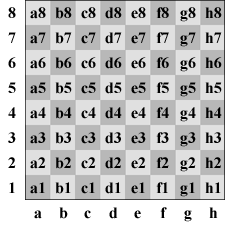
Appendix E: Algebraic notation
FIDE recognizes for its own tournaments and matches only one system of notation, the Algebraic System, and recommends the use of this uniform chess notation also for chess literature and periodicals. Scoresheets using a notation system other than algebraic may not be used as evidence in cases where normally the scoresheet of a player is used for that purpose. An arbiter who observes that a player is using a notation system other than the algebraic should warn the player about this requirement.
Description of the Algebraic System
E1. Each piece is indicated by the first letter, a capital letter, of its name. Example: K = king, Q = queen, R = rook, B = bishop, N = knight. (In the case of the knight, for the sake of convenience, N is used.)
E2.
For the first letter of the name of a piece, each player is free to use
the first letter of the name which is commonly used in his country.
Examples:
F = fou (French for bishop), L = loper (Dutch for bishop). In printed periodicals,
the use of figurines for the pieces is recommended.
E3.
Pawns are not indicated by their first letter, but are recognised by the
absence of such a letter.
Examples:
e5, d4, a5.
E4. The eight files (from left to right for White and from right to left for Black) are indicated by the small letters, a, b, c, d, e, f, g and h, respectively.
E5. The eight ranks (from bottom to top for White and from top to bottom for Black) are numbered 1, 2, 3, 4, 5, 6, 7 and 8, respectively. Consequently, in the initial position the white pieces and pawns are placed on the first and second ranks; the black pieces and pawns on the eighth and seventh ranks.
E6. As a consequence of the previous rules, each of the sixty-four squares is invariably indicated by a unique combination of a letter and a number.

E7.
Each move of a piece is indicated by
(a) the first letter of the name of the piece in question and
(b) the square of arrival.
There is no
hyphen between (a) and (b).
Examples:
Be5, Nf3, Rd1.
In the case
of pawns, only the square of arrival is indicated.
Examples:
e5, d4, a5.
E8.
When a piece makes a capture, an x
is inserted between
(a) the first letter of the name of the piece in question and
(b) the square of arrival.
Examples:
Bxe5, Nxf3, Rxd1.
When a pawn
makes a capture, the file of departure must be indicated, then an
x
,
then the square of arrival..
Examples:
dxe5, gxf3, axb5.
In the case
of an "en passant" capture, the square of arrival is given as the square
on which the capturing pawn finally rests and "e.p."
is appended to the notation.
Example:
exd6 e.p.
E9. If two identical pieces can move to the same square, the piece that is moved is indicated as follows:
- 1. If both pieces are on the same rank: by
- (a) the first letter of the name of the piece,
- (b) the file of the square of departure, and
- (c) the square of arrival.
- 2. If both pieces are on the same file: by
- (a) the first letter of the name of the piece,
- (b) the rank of the square of departure, and
- (c) the square of arrival.
- 3. If the pieces are on different ranks and files, method (1) is preferred. In the case of capture, an x must be inserted between (b) and (c).
There are two knights, on the squares g1 and e1, and one of them moves to the square f3: either Ngf3 or Nef3, as the case may be.
There are two knights, on the squares g5 and g1, and one of them moves to the square f3: either N5f3 or N1f3, as the case may be.
There are two knights, on the squares h2 and d4, and one of them moves to the square f3: either Nhf3 or Ndf3, as the case may be.
If a capture
takes place on the square f3,
the previous examples are changed by the insertion of an x:
(1) either
Ngxf3 or
Nexf3,
(2) either
N5xf3 or
N1xf3,
(3) either
Nhxf3 or
Ndxf3, as the case may be.
E10.
If two pawns can capture the same piece or pawn of the opponent, the pawn
that is moved is indicated by
(a) the letter of the file of departure,
(b) an x,
(c) the square of arrival.
Example:
If there are white pawns on squares c4
and e4 and a
black pawn or piece on the square d5,
the notation for White's move is either cxd5
or exd5, as the
case may be.
E11. In the case of the promotion of a pawn, the actual pawn move is indicated, followed immediately by the first letter of the new piece. Examples: d8Q, f8N, b1B, g1R.
E12. The offer of a draw shall be marked as (=).
Essential abbreviations:
0-0
castling with rook h1 or rook h8 (kingside castling)
0-0-0
castling with rook a1 or rook a8 (queenside castling)
x
captures
+
check
++
or #
checkmate
e.p.
captures "en passant"
Sample game:
1.d4 Nf6 2.c4 e6 3.Nc3 Bb4 4.Bd2 0-0 5.e4 d5 6.exd5 exd5 7.cxd5 Bxc3 8.Bxc3 Nxd5 9.Nf3 b6 10.Qb3 Nxc3 11.bxc3 c5 12.Be2 cxd4 13.Nxd4 Re8 14.0-0 Nd7 15.a4 Nc5 16.Qb4 Bb7 17.a5 ... etc.